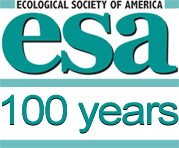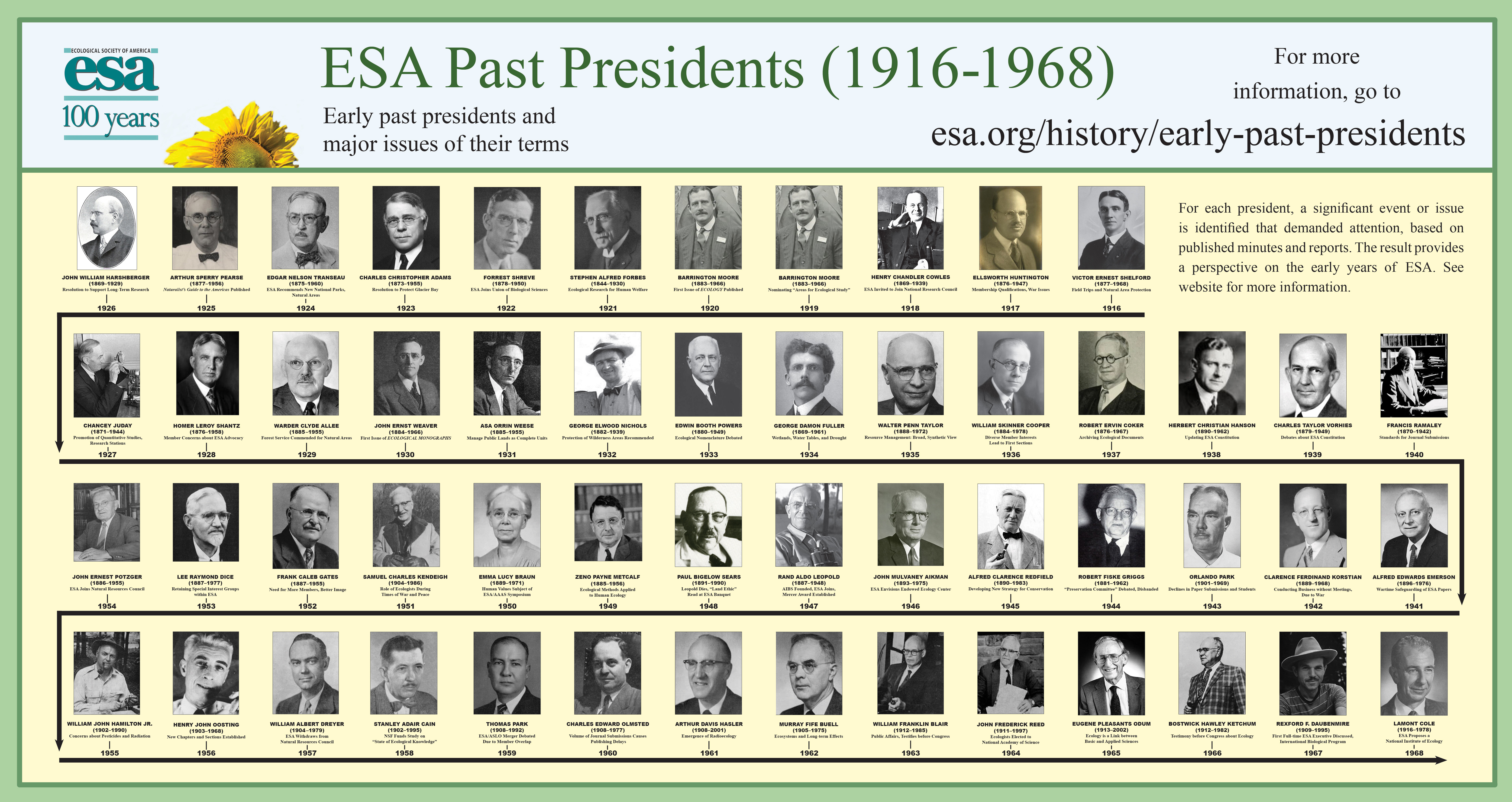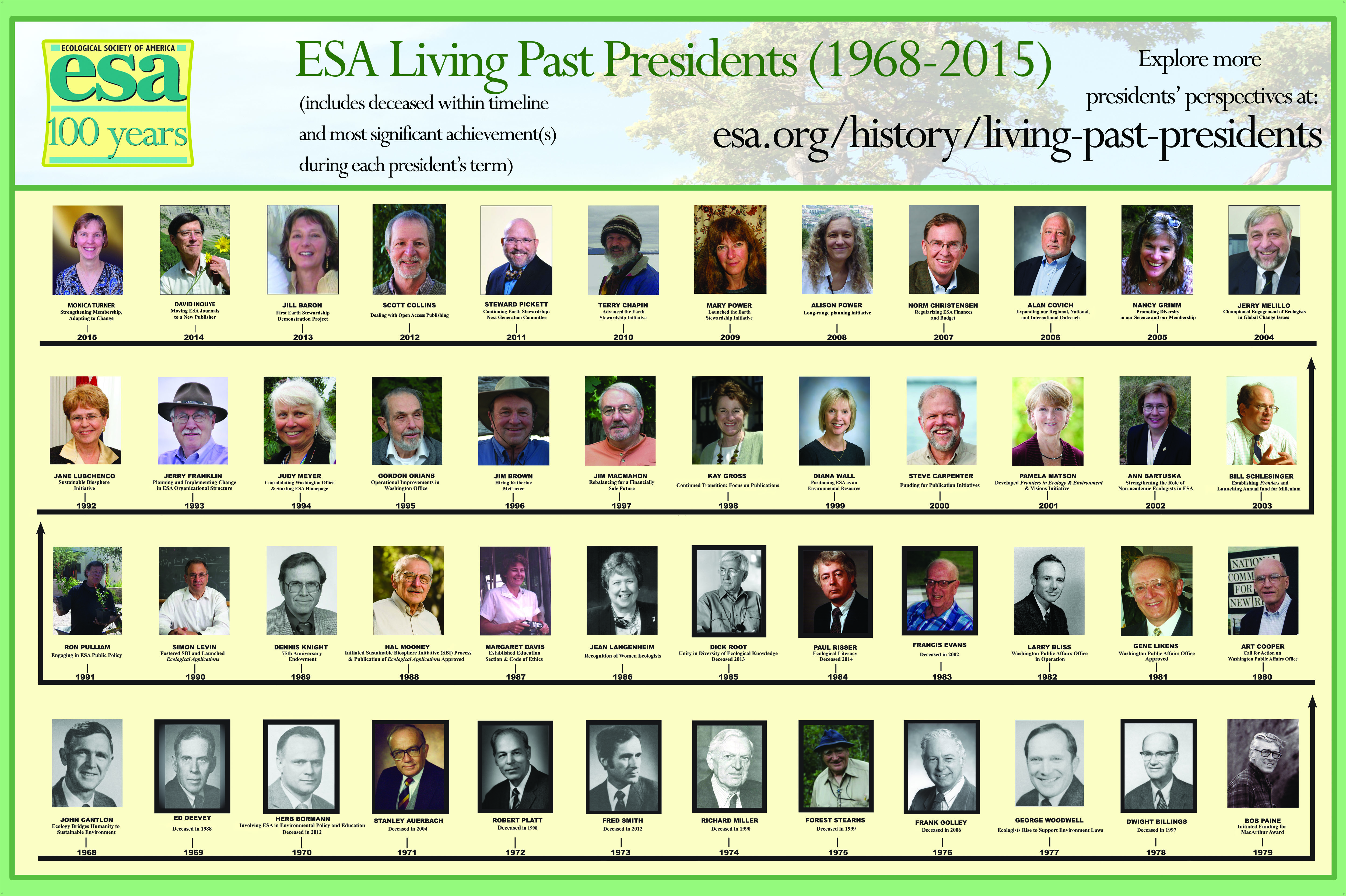ESA Past Presidents attending the Centennial Meeting in Baltimore gathered at a luncheon held in their honor. Front row, Left to right: Dennis Knight, 1989-1990) Steward Pickett, 2011-2012; Jill Baron, 2013-2014; Nancy Grimm 2005-2006; David Inouye, 2014-2015; Scott Collins, 2012-2013; Monica Turner, 2015-2016. Back row, Left to right: Mary Power, 2009-2010; Stuart “Terry” Chapin, 2010-2011; Alan Covich, 2006-2007; Simon Levin, 1990-1991; Hal Mooney, 1988-1989; Pamela Matson, 2001-2002; Diana Wall, 1999-2000; Eugene Likens, 1981-1982; Katherine “Kay” Gross, 1998-1999; Norman Christensen, 2007-2008; Robert Payne, 1979-1980; James Brown, 1996-1997
Letter from the President
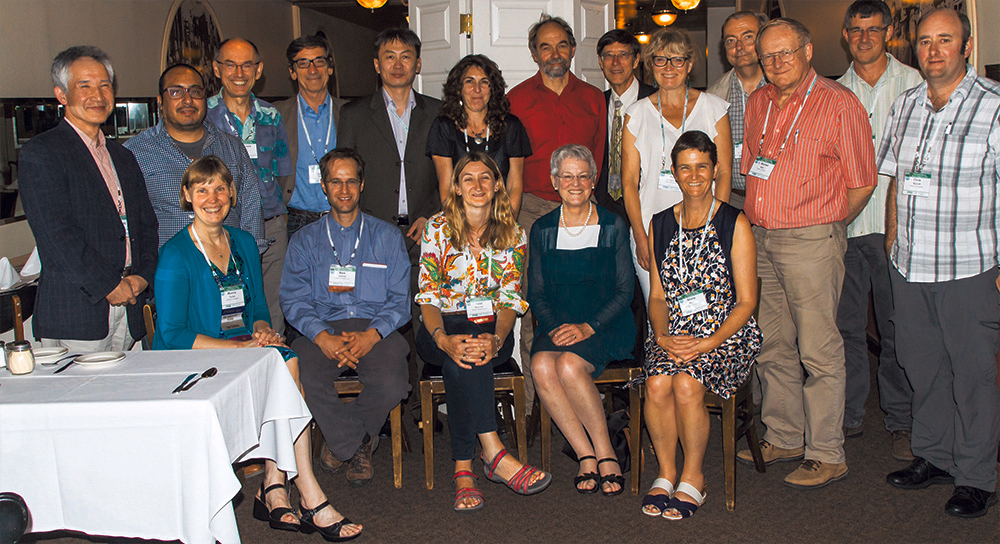
Leadership from over 13 international ecological societies attended a luncheon hosted by President Inouye at the Centennial Meeting in Baltimore, Maryland, August 2015.
I was pleased and honored to serve the ESA as President during much of its Centennial year. It was impressive to see how all the activities that have been in the planning stage for the past few years came together this year, including special issues of the journals, dedicated work by the Historical Records Committee, and many special events at the Annual Meeting in Baltimore. A highlight was the video birthday message from President Obama, congratulating the ESA for its longevity and what we do. That meeting was one of our best attended, with about half of the membership there to present their research, learn from colleagues, network, and enjoy the city. The closing social event, at a brewery and featuring several food trucks and a band, was a rousing success that had several times the usual attendance.
I undertook a project this past year to strengthen ties between the ESA and the other ecological societies in the world. I was fortunate to be able to attend annual meetings of the Ecological Society of Japan, the Ecological Society of Mexico, the joint annual meeting of the British and French Ecological Societies, and the European Ecological Federation, to hear about the research their members are doing, and interact with them. At our own Annual Meeting, I hosted a dinner meeting for representatives of many of the world’s ecological societies, and expect that this will be a continuing tradition. These societies have many similar goals, opportunities, and challenges, and it’s good to be able to share ideas and solutions. Perhaps the youngest society is the nascent Mongolian Ecological Society, and their representative presented the ESA with a very nice painting of the steppe habitat and its inhabitants.
This year ESA resolved one of the greatest challenges of its history: how to respond to the dramatically and rapidly changing world of scientific publishing (e.g., how many of you no longer have personal subscriptions to ESA journals?). The Governing Board realized that it had to change the model of self-publishing that worked for us for many decades, but was no longer viable. We hired a consulting group to advise us, interviewed several of the major scientific publishers as potential partners last spring, and this large effort will culminate with our journals being published as of 2016 with John Wiley & Sons. It’s sad to have to close the Ithaca-based publications office whose staff have served the society so well for many years, but our new partnership will bring new opportunities related to digital publishing, and we hope will increase our international subscriber base.
I was a participant in the SEEDS program’s 2015 Leadership Meeting in Maryland this spring, and was very impressed with the student participants and the ESA’s SEEDS program staff. It was also my pleasure to host a SEEDS field trip to the Rocky Mountain Biological Laboratory, where my research is based, and mentoring some SEEDS students there. If you haven’t already done so, consider working with these students as mentors, partners at the Annual Meeting, or in other ways. These young students are an important part of the future of ecology in this country.
Members of the Governing Board have a better opportunity than most ESA members to get to know and appreciate the staff who are crucial to keeping this society running, and making it so successful. The science program, education and diversity program, and public affairs program are all outstanding, and helping ESA members and our field in many ways. They offer many opportunities for professional development that you should take advantage of to advance your careers, whether they are in academia, consulting, education, government, policy, or other fields. Your participation will ensure our society remains vibrant as it enters its second century.

President David Inouye (August 2015−August 2016)
Letter from the Executive Director
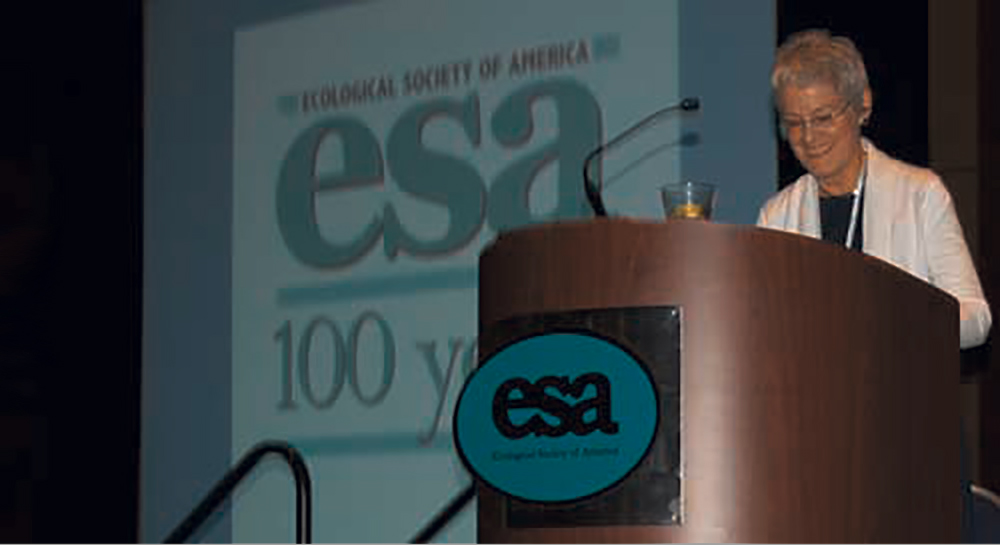
Katherine McCarter welcomes ecologist at the Centennial Meeting Opening Plenary.
ESA marked the midpoint of its Centennial year with an Annual Meeting that was both a reflection on our past and exploration of the future. What an honor it was for me to welcome registrants to this historic meeting in Baltimore, Maryland! The event was marked by a video greeting of congratulations from President Barack Obama, which was received with excitement and pride by all those assembled and later by those viewing it from our website. Other videos debuted in Baltimore, the Student Section produced a series of four animated video shorts that extracted the important messages from several classic papers in ecology —one of which was shown at the Scientific Plenary. Ecology in a Changing World, was produced just for the Centennial to celebrate the role of ecologists in society while looking to the future of the profession became available for viewing after the meeting on the ESA website and will be relevant long after the Centennial year. Representatives from over 15 ecological societies from around the world, ranging from the Ecological Society of Mongolia to the ecological societies of New Zealand, Australia, Argentina and Brazil, joined ESA to celebrate its Centennial.
We can be proud of our Centennial celebration—the history of ESA, current scientific findings, and speculation about the future all came together in an exciting meeting.
Leading up to the annual meeting many of our sections, chapters, and committees all traced their historical pasts and delved into their futures. Of special note were the timelines developed by the Historical Records Committee that recorded ESA milestones and reflections of Past Presidents. The ESA journals ran a series of Centennial papers and a recap of some of the most important papers from ecology’s past. This year also saw the launch of ESA’s second open access journal, Ecosystem Health and Sustainability, published jointly with the Ecological Society of China.
ESA’s Centennial year ushered in a dramatic change for ESA. After self-publishing its journals for most of its history, ESA will now have a publishing partner. Beginning in 2016, John Wiley & Sons will publish ESA subscription and online journals as well as the ESA Bulletin. This transition is expected to allow ESA to enhance its journals with upgraded technology and to better serve its authors, reviewers and editors. All ESA members will have free access to the journals in 2016. This move, necessitated by the changing market for scientific journals and the demand for ever more sophisticated technology, means that while ESA will continue to own its journals and exercise editorial control, the production will move to our Wiley. As a result, ESA closed its Ithaca publications office with a heartfelt thank you to many of the staff who produced our journals with skill and devotion over these many years. This is a bittersweet moment in our history as the Society takes steps to ensure its future.
Finally, I would be remiss if I did not acknowledge that what makes ESA so amazing is not only that it has thrived and grown over 100 years, but also that its community of members—you—have supported ESA with your knowledge, your dedication to ESA’s mission, with your dues and donations, and most precious of all, with your time by joining our sections, chapters and committees; your time as authors, reviewers and editors; and through the numerous other ways you volunteer your expertise to your professional society. You have made ESA a strong and vibrant professional society. Thank you!
![]()
Katherine McCarter
